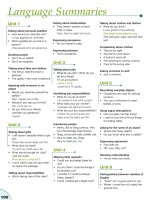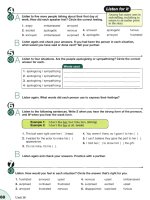Successful CRM in 3 easy steps
Bạn đang xem bản rút gọn của tài liệu. Xem và tải ngay bản đầy đủ của tài liệu tại đây (337.31 KB, 10 trang )
Successful CRM
in 3 easy steps
On the surface, CRM seems self explanatory.
It’s built on three key principles:
Customers
Relationships Management
Successful CRM depends on considering each of these elements individually,
but combining your efforts across all three to fulfil organisational goals and
customer satisfaction.
Step 1:
Prioritise the needs
of your customers
Customers should always be central to your CRM system
and strategy, they are your lifeblood. You should use CRM to
deliver a stronger service that meets their expectations.
Using a CRM, you can keep all customer
data in a central repository and achieve a
comprehensive view of all things customer
related. This will help you to retain
customers - new and old.
Increasing
customer
retention by just
5% can increase
profits between
25% and 95%.
Step 2:
Utilise data to
establish or
re-establish
relationships
CRM gives you a tool to capture relationship data,
analyse trends and identify new opportunities including upselling and cross-selling. You
can strengthen relationships by offering your
customers further services, simultaneously
improving the ROI of your company.
Marketing and Sales will play an important role in
establishing and cultivating these relationships.
“CRM almost makes everyone in your
organisation a sales person, since they are
selling your business in one way or another.
For instance, customers often say things to
support staff which could be used as a sales
opportunity. The support person might not know
it but because the information is recorded, a
salesperson can see it and use it to follow up.
Just the recording of the information has many
benefits for other departments.”
IDC
Step 3:
Manage and enrich your
customer relationships
The final step to successful CRM is managing your relationship with each customer,
creating value add and making them profitable. You also need tools to capture and
analyse relationship data to help keep sales, marketing and services on track.
CRM can also be used to automate many of the common account management
tasks to improve customer service, such as smoothing the transfer of leads
between marketing and sales.
Customer relationship doesn’t stop there though, you should still nurture
your customers after a sale has been made, ensuring they have a consistent,
end-to-end service.
“On average, sales and marketing costs range
from 15%-35% of total corporate costs. So the
effort to automate for more sales efficiency is
absolutely essential. In cases reviewed, sales
increases due to advanced CRM technology have
ranged from 10% to more than 30%.”
Harvard Business Review
The Ultimate Guide
to: Using CRM for
data driven marketing
success
The Ultimate
Guide to:
Using CRM for
data driven
marketing
success
An eGuide with practical steps to apply
data-driven marketing using CRM
Download Now
ULTIM
ATE SE
R
IES









